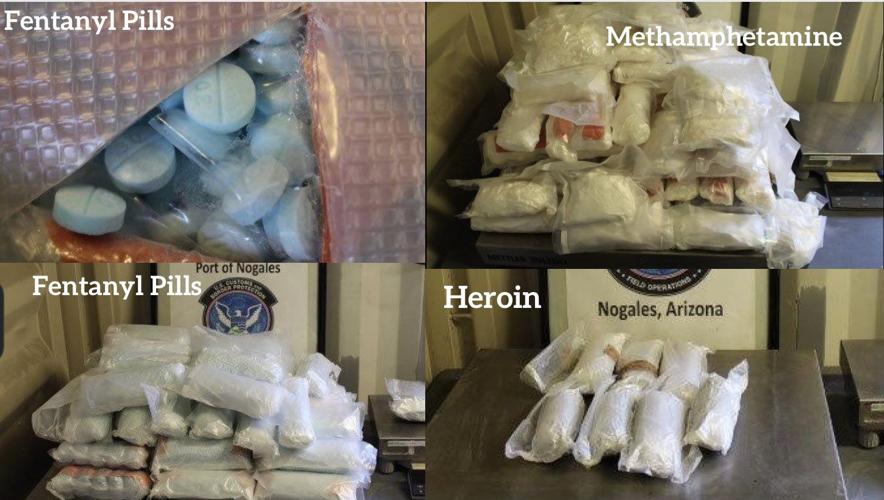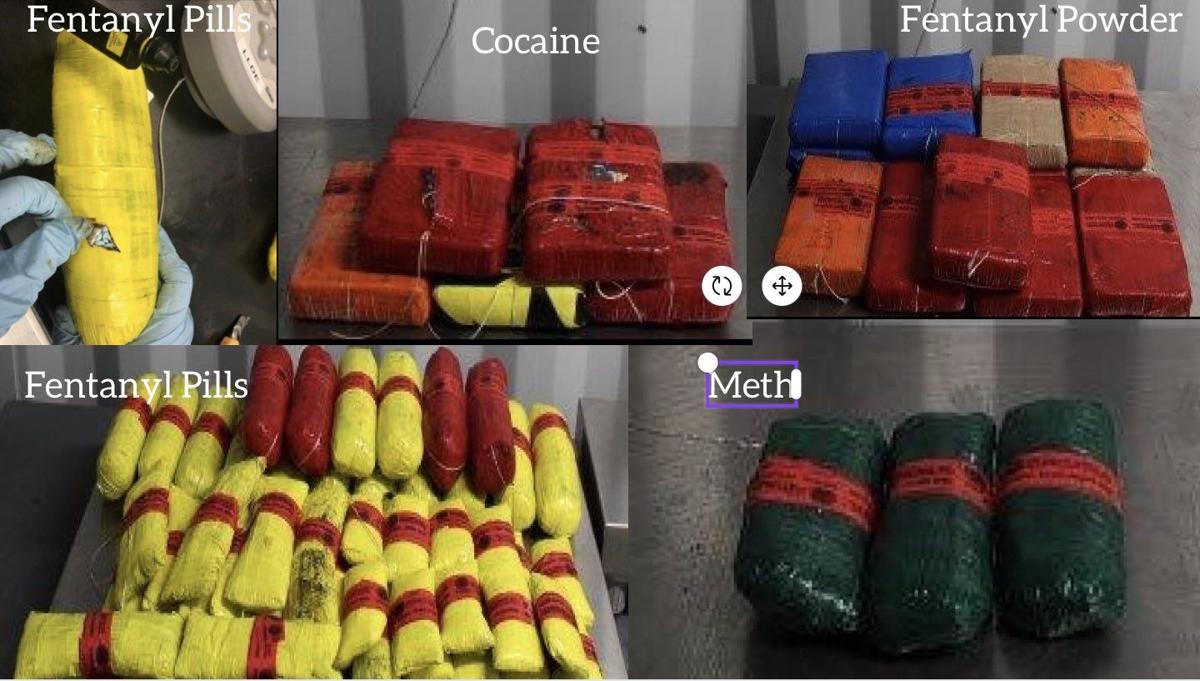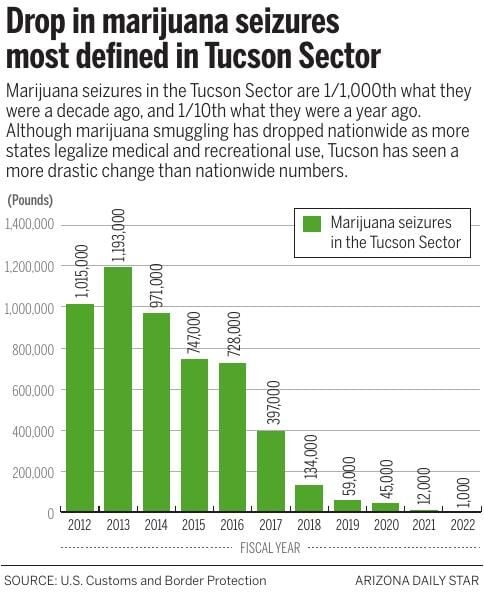Drug smuggling in Arizona has almost completely shifted away from marijuana and to harder drugs including fentanyl.
In Border Patrol sectors and at ports of entry in Arizona, marijuana seizures have nearly disappeared since the state’s voters legalized medicinal use in 2010 and recreational use in 2020, and as other states also legalized the plant.
In the Tucson Sector, marijuana seizures are about one-one-thousandth of what they were a decade ago and one-tenth of what they were a year ago.
In fiscal year 2012, Border Patrol agents in the sector, which covers most of Arizona’s southern border — 262 miles that stretch from New Mexico to Yuma County — seized more than a million pounds of marijuana.
Last fiscal year, they seized about 12,000 pounds. In the first nine months of the current fiscal year, they seized less than 900 pounds.
But fentanyl seizures are moving toward a 60% increase in the Tucson Sector and a 21% increase at Arizona ports of entry this year compared to last year.
Nogales port seizures have exceeded 5 million fentanyl pills so far this fiscal year, says Nogales Port Director Michael Humphries.
“Here in Nogales, we’ve seen high amounts of fentanyl, some of the highest along the Southwest border,” Humphries said. “Whatever transnational criminal organizations control this area here are heavy into fentanyl pills, methamphetamine, heroin and cocaine.”

Officers at an Arizona port of entry seized 150,000 fentanyl pills, 32 pounds of fentanyl powder, 13 pounds of cocaine and 5 pounds of meth that were concealed in the rocker panels of a vehicle. This was just one seizure they had that Saturday. Another seizure included 320,000 fentanyl pills, 89 pounds of meth, 9 pounds of brown heroin and 2.5 pounds of black tar heroin concealed in the gas tank, side and rocker panels of a vehicle attempting to enter the U.S.
Fentanyl-smuggling hotspot
The Sinaloa Cartel, which is in Sonora, is the primary pill maker for fentanyl, which can come in all shapes and colors, even made to look like prescription medication, says Cheri Oz, head of the Drug Enforcement Administration in Phoenix.
“The Sinaloa Cartel uses routes that come through Arizona,” Oz said. “So because they are the major producer of the fentanyl pill, we are seeing more fentanyl pills here in Arizona than other Southwest border states.”
Arizona has the second-highest amount of fentanyl seizures after California. Fentanyl seizures are on track to be about the same nationwide this year as last, while they are increasing dramatically year-over-year in Arizona.
Nogales, Arizona, has a population of around 20,000 people, so most of the 5 million fentanyl pills seized this year at its ports are not intended for Nogales residents, notes Humphries, the port director. Drugs that come through the Nogales ports are intended for Tucson, Phoenix and all over the country.
“They’re going throughout the U.S., so what we do here matters for Ohio and West Virginia and Connecticut and Kentucky where we’re seeing a high rate of overdose deaths from opioids,” he said.
There were nearly 81,000 overdose deaths in the U.S. involving opioids in 2021, according to the Centers for Disease Control, a 15% increase over 2020.
Here in Pima County, opioids in general, including fentanyl, contributed to at least 71% of the 498 overdose deaths during the 2021 calendar year, the county health department says.
Seizure weights drop
Although marijuana smuggling has dropped nationwide as more states legalize medical and recreational use, Arizona has seen a more drastic change than nationwide numbers, as there are still substantial marijuana seizures in Texas.
As well, the average weight of seizures in Arizona has dropped dramatically, to levels indicative of personal use rather than intent to distribute.
The marijuana seized in the Tucson Sector this fiscal year came from 360 seizures, meaning the average seizure was less than 2½ pounds. Just three years prior, in 2019, the average individual seizure was nearly 56 pounds.
Seizure weights during some months are even lower. For example, in May, there were 36 seizures that added up to one pound, meaning the average amount of marijuana confiscated in each was less than a half-ounce.
Although marijuana was legalized in Arizona last year — adults over 21 can legally carry one ounce for personal use — it is still federally illegal and federal agents are required to seize it, even many miles from the border.
Cartels move away from marijuana
Two likely reasons for the shift away from marijuana to harder drugs are that more states have legalized the once illicit plant and Americans’ addiction to fentanyl has increased.
“When we arrest somebody with marijuana, we just ask ‘Why?’” said Tucson Sector agent and spokesman Jesus Vasavilbaso. “It’s getting legalized in many different states so that marijuana is just not lucrative for the cartels anymore.
“Obviously cartels are always looking to make money. They’re not going to be put out of business just because you’ve legalized marijuana. So they just move to harder drugs.”
Vasavilbaso has been a Border Patrol agent for 13 years, and the drop in marijuana seizures has changed things, he says. For one, marijuana smugglers were easier to spot because the load was larger and more visible and had a strong smell. Now, when they find drugs on someone crossing the border, they don’t know until they look into the person’s backpack.
Tucson Sector agents have seized more than twice the amount of methamphetamine than marijuana this fiscal year.
It is a strategy of transnational criminal organizations, which control nearly all aspects of when and where migrants cross the border, to sometimes persuade migrants to carry drugs across the line. Agents also seize drugs from people going through Border Patrol checkpoints that are away from the border, often being smuggled by U.S. citizens.
Still, the vast majority of drugs now come through ports of entry, also often smuggled by U.S. citizens. Arizona customs officers at ports of entry confiscated more than 15,600 pounds of drugs so far this fiscal year, nearly five times what Tucson Sector agents seized.
Of fentanyl seized in Arizona sectors and ports this fiscal year, more than 80% was at ports of entry.
Hard-drug smuggling likely to increase
If you look at drug smuggling as a business model, the shift to harder drugs makes sense, says Victor Manjarrez Jr., former head of the Tucson Sector, who is now assistant director for the Center of Law and Human Behavior at the University of Texas-El Paso.
“When you talk about marijuana, you’re talking about a big logistical chain,” he said. “You have to have real estate to grow it. You have to have workers to attend to it, to harvest it. You’ve got to transport it. You’ve got to store it. You’ve got to let it dry. And then the profit margin isn’t all that great.”
Harder drugs, on the other hand — “you can cook that stuff in a house.”
And it’s easier to hide — 8 pounds of meth rather than 8 pounds of marijuana takes up less space and has a much higher profit margin.
Manjarrez thinks the transition to smuggling of harder drugs will just get more pronounced over time.
“I think you’ll see even less marijuana, and you’ll see harder drugs,” he said. “Quite honestly, I think you’re gonna see drugs that we don’t even know about yet, designer drugs.”
With a little over two months left in this fiscal year, fentanyl seizures have already exceeded last year’s complete total, which has happened every year for the last few, port director Humphries said. In 2014 there was probably no fentanyl seized, and in 2015 officers confiscated around 10,000 fentanyl pills, he said. This year, they’ve seized more than 5 million.
“When we exceed 5 million fentanyl pills, I don’t see it slowing down until the demand goes down,” he said. “It’s easy to get addicted to, so until we stop all that, it’s probably going to take a whole-government approach to be able to tackle this issue.”
RELATED:
County will be offering fentanyl testing strips along with Narcan so drug users can check if a substance contains fentanyl.
Unlike the city, which projected about $8 million in revenue for the fiscal year, Pima County did not budget any expected revenue from marijuana sales this year.
For Star subscribers: Fentanyl overdoses have now replaced car accidents as the leading cause of death for people 19 and younger in Pima County, as 2021 moves toward being a record year for all overdose deaths overall.











